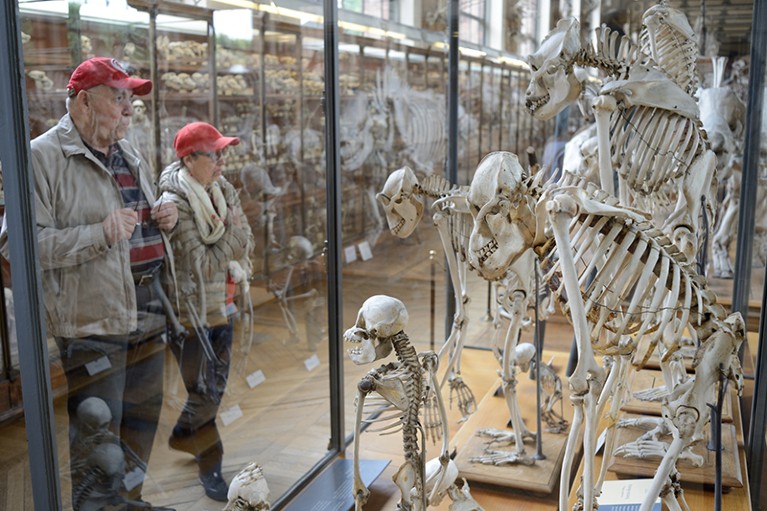
Credit: Soltan Frédéric/Getty
Humans are the only great apes to routinely walk on two legs, a posture that relies on us having long legs, short arms and narrow hips. A study1, published this week in Science, has generated a map of genomic regions that could explain how our unique skeletal architecture evolved. The work also points to regions of our DNA that place us at risk of the common skeletal disease osteoarthritis.
“Leonardo da Vinci thought about this 500 years ago — what the proportions of a human are,” says co-author and computational geneticist Vagheesh Narasimhan at the University of Texas at Austin.
Palaeoanthropologists have used the fossil record to extensively documented how the skeletal shape of hominins — humans and their extinct relatives — gradually changed over the past few million years. But the genetic basis of those skeletal changes have eluded researchers. “It has been difficult to get skeletal measurements and DNA on the same samples for a sufficiently large sample size to conduct a genetic study,” explains Peter Visscher, a quantitative geneticist at the University of Queensland in St Lucia, Australia.
Narasimhan and his colleagues turned to the UK Biobank, a repository of genetic and health data for half a million people, to obtain records that included whole-body X-ray images. They used artificial intelligence (AI) to weed out images that couldn’t be used in the analysis, such as blurred pictures and those of people with implants or amputations. They then applied further rounds of AI analyses to extract precise measurements of bone lengths from more than 31,000 records.
Visscher says that the paper is “a real tour de force and clever use of computational deep-learning methodology”.
Hallmarks of walking upright
The genome-wide map that Narasimhan and his colleagues generated identified 145 genetic locations associated with changes to skeletal proportions. Many of the identified regions are known to have roles in skeletal development and 45 of the locations overlapped a single protein-coding gene. Of those, 32 have previously been identified as resulting in abnormal skeletons when disrupted in mice, and 4 as causing rare skeletal diseases in humans.
The team investigated a range of skeletal ratios, such as hip width to shoulder width, forearm length to height, and torso length to leg length. Limb and torso proportions were linked to distinct regions of the genome, suggesting that their development is controlled by separate genetic programs.
Having longer legs than arms is a hallmark of walking upright, and genomic regions linked to changes in this ratio were different to similar regions in other great apes, a sign that these regions were under evolutionary selection in humans. The same was true for regions linked to narrow hips relative to overall height.
One theory for why early hominins evolved upright walking is that their bodies were better able to keep cool in hot environments. Using biobank data on metabolic rate and body mass, the researchers found support for this hypothesis: as leg length increases, heat dissipation to stay cool improves. “There is this correlation between skeletal proportions and metabolic rate and fat-free body mass, which is in line with what the theory would predict,” says Narasimhan.
“This is really great work,” says evolutionary geneticist Yukinori Okada at the University of Osaka in Japan, who has conducted genomic-association studies looking for the genetic basis of human height. He would like to see the work replicated in other populations.
Genes associated with osteoarthritis
As well as providing insights into the evolutionary origins of the human body form, the study identified genetic regions associated with osteoarthritis of the hips and knees — a disorder that, according to Narasinham, is a leading cause of disability in the United States. This approach of pairing imaging and genetic data could be used to look for the genetic cause of other conditions, such as one leg being longer than the other, or how pelvic proportions changed through evolution, he says.
Bo Xia, a genomics researcher at Harvard University in Cambridge, Massachusetts, says that further work to identify the genetic elements responsible is needed, but will be challenging. Genome-wide association studies are powerful tools for identifying candidates for future research, he says, but pin-pointing which genes directly affect the developmental processes is not straight-forward if genetic variation occurs outside of gene-coding sequences. “A non-coding region mutation near a specific gene doesn’t necessarily indicate that the variant is affecting the gene that’s close to it,” he says.
Narasimhan’s team is taking those necessary next steps, using gene-edited zebrafish (Danio rerio) to investigate whether the identified genes alter skeletal formation in a model organism.





More News
Editorial Expression of Concern: Leptin stimulates fatty-acid oxidation by activating AMP-activated protein kinase – Nature
Quantum control of a cat qubit with bit-flip times exceeding ten seconds – Nature
Venus water loss is dominated by HCO+ dissociative recombination – Nature